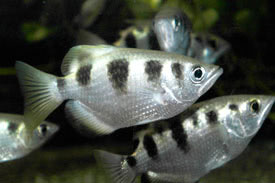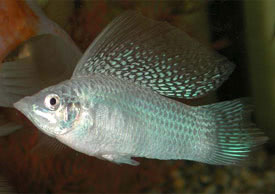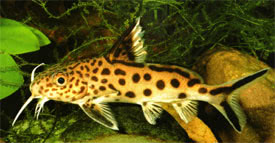
 Magyarul / Hungarian
Magyarul / Hungarian


- Scientific name: Toxotes jaculatrix
- Common name: Archerfish
- Group: Brackish fishes
- Habitat: Southeast Asia and Australia; India, Burma (Myanmar), Thailand, Malaysia, Philippines, Indonesia, to the Soloman Islands.
- Size: 24 cm
- Biotope: Found in brackish water (occasionally fresh) estuaries and mangrove swamps.
- Social behavior: The Archerfish may be skittish when kept with larger fish.Archerfish form schools and shouldbe kept in groups.Avoid combining Archerfish of different sizes as they may lack cohesion, with larger fishharassing smaller ones.A peaceful, calm fish recommended for a brackish water community tank.
- Diet: Takes food from the surface.Live: Insects; flies, spiders, crickets, mosquitoes, grasshoppers,beetles, cockroaches, meal worms; worms; insect larvae; crustaceans; small surface fish. May occasionally takes flakes and pellets.
- Breeding: Breeding has only been accomplished on a few occasions and details are little.
- Tank: Minimum 500 litres
- Population: 5-6 fishes for 500 litres
- Decoration: Archerfish prefer tanks at one-half to three-fourths full. Useplants that grow above the water surface that can tolerate brackish water. Provide hiding places with heavily plantedareas, rocks, roots, and wood.Leave some open swimming areas.
- Temperature: 25-30°C
- pH: 8-8,3
- Hardness: 10-20NK°
- Salinity: 5-20%
- Lifespan: 7-8 years
One thing that is often overlooked with Archers is that they are in fact brackish water fish, not freshwater. It is true that they will survive for a certain length of time in freshwater, especially when younger, but to keep these fish long term, a brackish environment is required.
Breeding Archers has only been accomplished on a very few occasions, usually when least expected. There is no known way to sex Archers, which means that groups must be kept if you want your fish to breed. The pair spawns at the surface and up to 3000 floating eggs will be laid. To ensure the survival of the fry, the eggs should be transferred to a holding tank, where they will hatch in around 12 hours. The fry should be fed items that can be taken from the water surface, such as small insects and other floating foods. Live foods are the most easily accepted, although the fry should be introduced to prepared foods as early as possible to prevent them getting too attached to live food.








